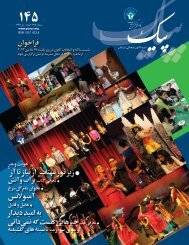Create successful ePaper yourself
Turn your PDF publications into a flip-book with our unique Google optimized e-Paper software.
EDUCATION<br />
by Sheiveh Jones<br />
I recently engaged in a conversation with someone who had asked<br />
me how the beginning teachers in my program did this year. Little<br />
did I know she was lulling me into a comfortable conversation so<br />
she could interject her emphatic opinion that “illegals” and parents<br />
who cannot speak <strong>English</strong> bring down test scores and are ruining<br />
public education. Needless to say, I was initially appalled by her<br />
comment and ready to disengage from the conversation, but as I<br />
thought it over, I realized this is not the first person I have heard<br />
this opinion from. Given I often think about understanding the root<br />
of the problem, I reflected on this person’s comment and asked<br />
myself whether she really understood what test scores mean. My<br />
answer? No.<br />
The test scores she referred to were the California<br />
Standards Test also known as the CST. Students in second grade<br />
and above take this exam around May every year. The test assesses<br />
how well students learned standards taught to them up to that point.<br />
If you are a parent with a child in public education, chances are you<br />
are familiar with this assessment; you also might recall receiving<br />
test scores in the mail every summer indicating whether your child<br />
earned a score of advanced, proficient, basic, below basic, and far<br />
below basic. From second grade up all students are assessed in<br />
math and language arts. In fifth grade and up they are assessed in<br />
science and from sixth grade up they are assessed in history-social<br />
science. But what in the world do these assessments really mean<br />
and what can you glean from your child’s test scores? Before I<br />
explain this, I need to explain “behind-the-scenes” planning more<br />
and more schools employ to prepare for these assessments.<br />
In response to testing, several districts, schools, and<br />
grade level (or subject matter) teachers determined they must<br />
come together within their districts to create a pacing guide. The<br />
pacing guide maps out what must be taught throughout the year;<br />
it is broken down into days, weeks, or months. Looking at the<br />
CST Blueprint and analyzing how many questions target each of<br />
the standards determine all this. For instance, if there are several<br />
questions focused on one particular standard, more time will be<br />
spent teaching that concept. Essentially, the idea is to map out<br />
the school year in a way to prepare students for the CST, thus the<br />
term “teaching to the test.” You might have heard of benchmark<br />
assessments. These are district or school created tests administered<br />
periodically throughout the year to make sure students are on<br />
the right track to doing well on the CST. Teachers are supposed<br />
to analyze the benchmarks to guide their own teaching. If they<br />
notice several students missed a particular problem correlated to<br />
a particular standard, this is a good indicator they must go back<br />
and re-teach the concept. If the school does not use benchmark<br />
assessments, it is up to each individual teacher to make sure he/<br />
she consistently assesses students’ knowledge based on standards<br />
throughout the year.<br />
Yes, this is indeed quite complicated particularly in<br />
elementary school where one teacher teaches multiple subjects.<br />
But again, what does this mean to you as a parent when you<br />
receive the test scores during the summer? The CST scores are a<br />
good indicator of how well your child met the standards for his/<br />
her grade level. But it truly goes deeper than that. There is a comic<br />
strip we often laugh at as educators. It is a picture of two teachers<br />
standing in the teacher’s lounge with one telling the other “I taught<br />
it so I know they learned it.” The comedy in this is that imparting<br />
information to the class does not mean students have learned it.<br />
A good teacher goes far beyond imparting information. A good<br />
teacher does in fact map out what will be taught throughout the<br />
year. This mapping will assist the teacher in planning effective<br />
instructional strategies and assessing student learning. Assessing<br />
student learning should be used to help a teacher reflect on his/her<br />
teaching to decide what changes must be made.<br />
When you look at your child’s scores, you will want to see<br />
either advanced or proficient. This indicates your child is on target<br />
with where he/she should be. Basic indicates your child is on the<br />
border of being on target while below basic and far below basic<br />
indicates your child is not fully meeting the standards for his/her<br />
grade level. No matter what score your child receives, you should<br />
ask yourself (and possibly the teacher or school) the following<br />
questions:<br />
• Was there a pacing guide so the teacher could ensure he/she<br />
was on target to teaching all the standards assessed?<br />
• Did the teacher assess my child’s progress throughout the<br />
year to make sure my child was on target?<br />
• What instructional strategies did the teacher use throughout<br />
the year to make sure my child had opportunities to interact<br />
with and process the information taught?<br />
• Was I involved in my child’s learning by supporting what<br />
was being taught (i.e. helping child with homework, reading<br />
to child, etc)?<br />
• Lastly, does my child have special needs that either the<br />
school/teacher or I is unaware of?<br />
These questions are great in helping guide your next steps in<br />
making sure your child’s learning needs are met.<br />
So what did I tell the individual who blamed the problems<br />
of public education on “illegals” and parents who don’t speak<br />
<strong>English</strong>? Every parent wants his/her child to be successful so to<br />
blame test scores on this particular group of parents is irrational. I<br />
rest most of the responsibility on the teacher and what goes on in<br />
the classroom. We know, as research shows, it takes one adult in a<br />
child’s life to have a great impact. This adult is often a teacher. This<br />
impact could be good or bad. A good teacher will ensure the child<br />
progresses. I personally have seen this first hand in the last six<br />
years in the extensive work I have done with beginning teachers<br />
and have been amazed by the impact an effective teacher has on a<br />
child’s success.<br />
Note: for more information about testing, go to www.cde.gov<br />
For the CST Blueprint go to www.cde.ca.gov/ta/tg/sr/blueprints.asp<br />
Sheiveh has worked in public education for twelve years; she<br />
taught high school math and <strong>English</strong>. Currently, she directs a<br />
program that mentors beginning teachers from twelve local school<br />
districts and inducts them into the profession.<br />
14<br />
No. 122/ July-August 2009

















